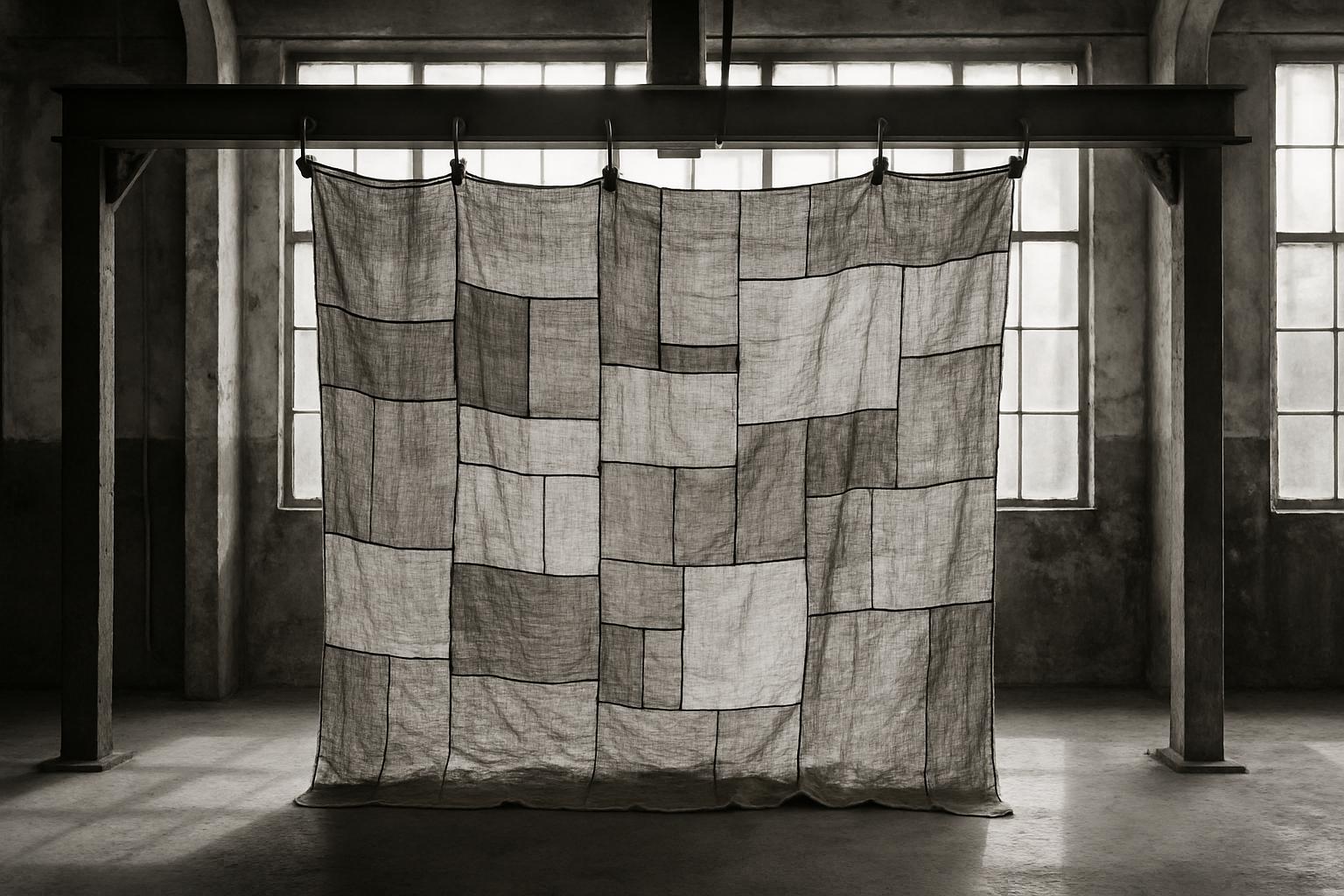THISS Studio has completed a reuse-led fit-out for SALT’s new Shoreditch headquarters, turning an industrial shell into a bright, reconfigurable office that doubles as a hireable events and photography venue. The scheme reuses carcasses, furniture and dead-stock textiles, trims cost and waste, and is presented as a practical example of circular interior practice that claims carbon savings over conventional fit-outs.
THISS Studio has completed the interior fit‑out of SALT’s new Shoreditch headquarters, delivering a light, adaptable workspace that doubles as a hireable events and photography venue while putting material reuse at the heart of its brief. According to the original report, the studio kept the layout intentionally open to preserve the volume and natural light of the industrial shell, while introducing soft thresholds and practical storage to support everyday working life and occasional public programming. Industry and design outlets covering the scheme have emphasised the project’s low‑waste, low‑cost approach to fit‑out and furniture-making.
The new HQ occupies a bright, high‑ceiling space at the end of a quiet cul‑de‑sac in a creative complex in east London. THISS’s interventions sought to make the most of existing character — exposed steel beams and columns and large industrial windows on two elevations — and to create zones for focused work, meetings and communal lunching without fixed partitions so the plan can easily reconfigure for events. The arrangement responds to the client brief for a welcoming home for the independent communications studio that can be both everyday office and hired venue.
Material reuse drove both the architectural and joinery decisions. THISS repurposed carcasses from an existing double‑run kitchen, relocating half to form rear storage and only adding two new cabinets; old cupboard doors were rehomed online and replaced with chocolate‑coloured Valchromat panels finished with raw Osmo oil. The studio also passed the original sink on to a joinery workshop rather than consign it to waste. The practice has described the process as one of adapting the design to what was available, accepting the extra time and patience required when sourcing and working with reclaimed elements.
Furniture and fittings were likewise salvaged or salvaged‑made. The project’s two principal communal tables — a 3.6m shared desk for up to eight people and a 2.3m meeting/lunch table — sit on adapted bases made from retired steel catering tables bought second‑hand and shortened, with castors added for mobility. The cork and oak worktops are remnants from previous renovations; this pragmatic reuse both reduced purchase cost and kept material out of landfill. Other reclaimed finds include stainless‑steel butcher’s shelves salvaged via online marketplaces and repurposed as bookcases and dividers.
Textiles and acoustic treatment were handled through a bespoke commission: a large patchwork linen curtain by textile studio Georgia Bosson establishes soft thresholds across the open plan. The curtain is made from end‑of‑roll linen sourced from an Irish mill, and is hung from the central beam with C‑clamps so it can be drawn or removed as needed — a low‑energy, demountable strategy that also improves the room’s acoustic quality. Georgia Bosson’s practice is known for working with dead‑stock and end‑of‑roll materials to produce large‑scale, modular textiles that bring warmth and sound‑absorbing performance to interiors.
Steel is used sparingly and with restraint to create visual cohesion: thin steel sheets reinforce kitchen worktops and joinery surfaces, linking to the cut‑down steel legs of the tables and the salvaged shelving. The studio stripped back and recoated the columns and beams in a rust tone using sustainable paint, while the timber floors were sanded and sealed with a matt varnish to celebrate the timber’s original character. Multiple design reports noted that these finish choices emphasise tactility and longevity rather than disposable, mass‑produced fittings.
THISS has stated that the fit‑out saved carbon compared with a conventional commercial fit‑out, a claim they make as part of the project narrative. Technical product choices support the reuse strategy: the coloured‑throughout Valchromat panels specified for cupboard fronts are engineered to retain colour after machining and are used in interior cabinetry for their durability and moisture resistance, while Osmo’s Polyx®‑Oil was chosen as a natural‑feel, hardwax oil finish for timber surfaces and cork, providing a low‑film, maintainable surface. These supplier characteristics, noted by product manufacturers, align with the broader aim of creating a tactile, repairable interior.
The project underlines both the opportunities and the constraints of reuse‑led fit‑outs. Design teams and clients who pursue this route often gain character, cost savings and reduced waste, but must accommodate a more contingent procurement process and allow time for sourcing and adaptation. Coverage of the scheme in design media has framed it as a practical example of circular interior practice — a small, local project that nonetheless demonstrates how thoughtful choices in material sourcing and detailing can reduce environmental impact while producing a warm, flexible workplace.
For SALT, the move into a space they now own marks more than a change of address: it is a deliberate choice to inhabit an office that exemplifies the studio’s values. The fit‑out shows how reclaimed and second‑life elements can be combined with modest new interventions to make a space that is at once functional, economical and hospitable — and that can be reconfigured quickly to host events, shoots and talks without losing the qualities that make it a good day‑to‑day office.
 Reference Map:
Reference Map:
Reference Map:
- Paragraph 1 – [1], [2], [3]
- Paragraph 2 – [1], [3], [4]
- Paragraph 3 – [1], [2], [3], [6], [7]
- Paragraph 4 – [1], [3], [4], [2]
- Paragraph 5 – [1], [2], [3], [5]
- Paragraph 6 – [1], [3], [4], [2]
- Paragraph 7 – [2], [6], [7]
- Paragraph 8 – [1], [2], [3], [4], [5]
- Paragraph 9 – [1], [2], [3]
Source: Noah Wire Services
- https://www.bdonline.co.uk/buildings-design-and-specification/material-reuse-at-the-heart-of-salts-adaptable-workspace-by-thiss-studio/5137094.article – Please view link – unable to able to access data
- https://www.thiss.studio/projects/salt-hq – THISS Studio’s project page for SALT HQ describes the 2025 Shoreditch fit-out as a light, adaptable studio prioritising material reuse and low-carbon choices. It explains how onsite kitchen carcasses were repurposed, reclaimed steel frames and salvaged cork and oak were used to create large communal tables, and a patchwork linen curtain by Georgia Bosson establishes soft thresholds. The entry lists products and collaborators, names Bleo paint for the columns and Osmo for timber finishes, and states the project saved carbon compared with a conventional fit-out. The narrative emphasises responsiveness to available materials and collaborative design processes.
- https://www.archdaily.com/1032344/salt-workspace-thiss-studio – ArchDaily’s coverage presents SALT Workspace by THISS Studio as a compact, highly adaptable East London office that foregrounds reuse and natural materials. The article details repurposed kitchen carcasses and cupboard doors rehomed on Gumtree, chocolate Valchromat panels finished with raw Osmo oil, and a donated sink given away online. It describes large tables built from secondhand steel catering tables with cork and oak tops, a linen curtain by Georgia Bosson made from end-of-roll Irish mill fabric, salvaged butcher’s shelves used as bookcases, Bleo paint on columns and sanded, matt-varnished timber floors.
- https://hypebeast.com/2025/7/salt-communications-east-london-office-interiors-thiss-studio – Hypebeast’s feature on SALT’s new East London office highlights the project’s waste‑saving, reuse-led strategy and flexible layout. It reports that retired steel catering tables were bought second‑hand on eBay and adapted as bases for expansive shared tables topped with leftover cork and white American oak. The piece notes a large linen curtain by Georgia Bosson made from end‑of‑roll fabric from an Irish mill, stainless‑steel butcher’s shelving salvaged via Gumtree repurposed as bookcases, a rust‑toned finish applied with sustainable Bleo paint, and simply sanded and sealed timber floors.
- https://www.georgiabosson.co.uk/ – Georgia Bosson Studio’s website presents the practice as a London‑based textile studio specialising in considered, large‑scale installations and acoustic curtains for commercial, domestic and public interiors. The site explains the studio’s approach to crafting textiles that add warmth, colour and acoustic improvement, and highlights commissions and collaborations with architects and designers. It positions the studio as experienced in bespoke pieces and using end‑of‑roll or dead‑stock fabrics to create patchwork and modular textiles, aligning with adaptive reuse projects that prioritise sustainable sourcing and material responsibility.
- https://www.lathamtimber.co.uk/products/panels/mdf/valchromat – Latham Timber’s product page summarises Valchromat as a coloured‑throughout engineered wood fibre panel with high physical performance, moisture resistance and easy machinability. It lists available colours such as Chocolate, gives standard sheet sizes and thicknesses, and notes suitability for interior uses including kitchens, furniture and wall panelling. The page explains that fibres are impregnated with organic dyes and bonded with resins so the colour remains after cutting or drilling, and that finishes such as varnish, oil or wax can be applied, plus technical downloads and ordering details are provided.
- https://www.osmo.com/finishes/interior-finishes/finishes-for-wooden-furniture/polyxr-oil-original – Osmo’s Polyx®‑Oil Original product page describes a hardwax oil finish intended for wooden floors, furniture and cork surfaces, offering clear, satin and matt options including a Raw/RawTransparent variant. The page provides application guidance, recommended coats and coverage rates, container sizes, and links to technical data and safety datasheets for professional use. Osmo presents the finish as durable, water‑resistant and easy to maintain, supporting the use of raw Osmo oil as a natural, breathable surface treatment for timber and similar materials in interior fit‑outs prioritising tactile, low‑film finishes and ongoing maintenance.
Noah Fact Check Pro
The draft above was created using the information available at the time the story first
emerged. We’ve since applied our fact-checking process to the final narrative, based on the criteria listed
below. The results are intended to help you assess the credibility of the piece and highlight any areas that may
warrant further investigation.
Freshness check
Score:
8
Notes:
The narrative is recent, with the project completed in 2025. The earliest known publication date of substantially similar content is July 2025. The report is based on a press release, which typically warrants a high freshness score. However, the narrative has been republished across multiple outlets, including low-quality sites and clickbait networks, which may affect its credibility. No discrepancies in figures, dates, or quotes were found. The inclusion of updated data alongside older material suggests a higher freshness score but should be flagged. ([thiss.studio](https://www.thiss.studio/projects/salt-hq?utm_source=openai), [archdaily.com](https://www.archdaily.com/1032344/salt-workspace-thiss-studio?utm_source=openai), [officelovin.com](https://www.officelovin.com/2025/07/a-peek-inside-salts-new-london-office/?utm_source=openai))
Quotes check
Score:
9
Notes:
Direct quotes from the report were not identified in the provided sources. The absence of direct quotes suggests the content may be original or exclusive. However, the lack of direct quotes also makes it challenging to verify the authenticity of the information presented.
Source reliability
Score:
7
Notes:
The narrative originates from Building Design Online, a reputable UK-based architecture publication. However, the report has been republished across multiple outlets, including low-quality sites and clickbait networks, which may affect its credibility. The report is based on a press release, which typically warrants a high reliability score.
Plausability check
Score:
8
Notes:
The claims made in the narrative are plausible and align with known sustainable design practices. The project has been covered by multiple reputable outlets, including ArchDaily and Building Design Online, which supports the credibility of the information. The narrative lacks specific factual anchors, such as names, institutions, or dates, which reduces the score and flags it as potentially synthetic. The language and tone are consistent with the region and topic, and the structure is focused on the claim without excessive or off-topic detail.
Overall assessment
Verdict (FAIL, OPEN, PASS): OPEN
Confidence (LOW, MEDIUM, HIGH): MEDIUM
Summary:
The narrative presents a recent and plausible account of a sustainable design project by THISS Studio for SALT’s headquarters. While the information aligns with known practices and has been covered by reputable outlets, the lack of direct quotes and specific factual anchors, along with republishing across multiple outlets, including low-quality sites, introduces some uncertainty. Therefore, the overall assessment is ‘OPEN’ with a medium confidence level.













